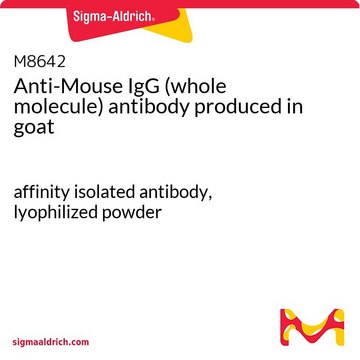76085
Anti-Mouse IgG - Atto 594 antibody produced in goat
~1 mg/mL protein, affinity isolated antibody
Synonyme(s) :
Atto 594 - goat-Anti-mouse IgG
About This Item
Produits recommandés
Source biologique
goat
Conjugué
Atto 594 conjugate
Forme d'anticorps
affinity isolated antibody
Type de produit anticorps
secondary antibodies
Clone
polyclonal
Contient
50% glycerol as stabilizer
Espèces réactives
mouse
Concentration
~1 mg/mL protein
Fluorescence
λex 603 nm; λem 625 nm in PBS
Conditions d'expédition
wet ice
Température de stockage
−20°C
Modification post-traductionnelle de la cible
unmodified
Description générale
Affinity isolated antigen specific antibody is purified from goat anti-mouse IgG antiserum to remove essentially all goat serum proteins, including immunoglobulin. Goat anti-mouse IgG associates with mouse IgGs.
Immunogène
Application
Remarque sur l'analyse
Informations légales
Clause de non-responsabilité
Vous ne trouvez pas le bon produit ?
Essayez notre Outil de sélection de produits.
Code de la classe de stockage
10 - Combustible liquids
Classe de danger pour l'eau (WGK)
WGK 1
Point d'éclair (°F)
Not applicable
Point d'éclair (°C)
Not applicable
Équipement de protection individuelle
Eyeshields, Gloves
Certificats d'analyse (COA)
Recherchez un Certificats d'analyse (COA) en saisissant le numéro de lot du produit. Les numéros de lot figurent sur l'étiquette du produit après les mots "Lot" ou "Batch".
Déjà en possession de ce produit ?
Retrouvez la documentation relative aux produits que vous avez récemment achetés dans la Bibliothèque de documents.
Les clients ont également consulté
Articles
Immunoblotting (Western blot transfer) is a common technique in modern proteomics research.
Notre équipe de scientifiques dispose d'une expérience dans tous les secteurs de la recherche, notamment en sciences de la vie, science des matériaux, synthèse chimique, chromatographie, analyse et dans de nombreux autres domaines..
Contacter notre Service technique









